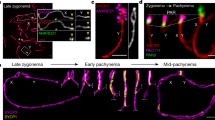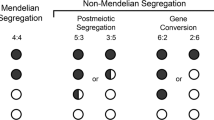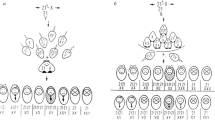Abstract
ALTHOUGH chiasmata have long been thought to be sites of crossing over exchange between chromosomes during meiosis, in keeping with the partial chiasmatype hypothesis1,2, there has been no convincing visual evidence of this despite many attempts (summarised in refs 3–6). Taylor7 confirmed by autoradiography that meiotic crossing over occurs by exchange involving breakage and reunion of chromatids. However, because of the poor resolution of autoradiography, requiring study of meiotic chromosomes after 1st metaphase, and because of interference by sister chromatid exchanges, a one-to-one correspondence between chiasmata and exchanges of labelled chromatid segments could not be established8,9. The difficulty was alleviated by correlating chiasmata and exchanges with temperature variation10, or by selecting a species with localised chiasmata and thus with predictable points of exchange11. 5-Bromodeoxyuridine (BUdR) substitution with differential labelling and consequent differential staining of mitotic chromosomes12–15 offer the potential for studying chromosomes at 1st meiotic metaphase, giving an unequivocal picture and separating sister chromatid exchanges from chiasma exchange points between homologues. Tease16 has reported success with male grasshopper meiotic chromosomes, but an attempt with the male mouse showed only sister chromatid exchanges in the sex chromosomes, and the autosomal bivalents at 1st meiotic metaphase were not differentially stained17. In the male Armenian hamster the sex chromosomes showed differential staining and an apparent exchange of segments but again the autosomes were not critically differentially stained18. This may be partly due to the make-up of the male meiotic chromosomes. We have overcome these problems by using an in vitro/in vivo technique19 which enables us to expose the differentiating germ cells of embryonic ovaries to BUdR in vitro and to collect and display the chromosomes20 of the mature oocytes some time after transplantation into young spayed adults. We report our results here.
This is a preview of subscription content, access via your institution
Access options
Subscribe to this journal
Receive 51 print issues and online access
$199.00 per year
only $3.90 per issue
Buy this article
- Purchase on Springer Link
- Instant access to full article PDF
Prices may be subject to local taxes which are calculated during checkout
Similar content being viewed by others
References
Janssens, F. A. Cellule 25, 387–411 (1909).
Janssens, F. A. Cellule 34, 133–359 (1924).
Brown, S. W. & Zohary, D. Genetics 40, 850–873 (1955).
Whitehouse, H. L. K. in Towards an Understanding of the Mechanism of Heredity, 3rd edn, 89–136, 341–342 (Edward Arnold, London, 1973).
White, M. J. D. Animal Cytology and Evolution, 3rd edn, 159–188 (Cambridge University Press, 1973).
Catcheside, D. G. in The Genetics of Recombination, 90–91 (Edward Arnold, London, 1977).
Taylor, J. H. J. Cell Biol. 25, 57–67 (1965).
Moens, P. B. Chromosoma 19, 277–285 (1966).
Craig-Cameron, T. & Jones, G. H. Heredity 25, 223–232 (1970).
Peacock, W. J. Genetics 65, 593–617 (1970).
Jones, G. H. Chromosoma 34, 367–382 (1971).
Latt, S. A. Proc. natn. Acad. Sci. U.S.A. 70, 3395–3399 (1973).
Allen, J. W. & Latt, S. A. Nature 260, 449–451 (1976).
Bloom, S. E. & Hsu, T. C. Chromosoma 51, 261–267 (1975).
Vogel, W. & Bauknecht, T. Nature 260, 448–449 (1976).
Tease, C. Nature 272, 823–824 (1978).
Allen, J. W. & Latt, S. A. Chromosoma 58, 325–340 (1976).
Allen, J. W., Shuler, C. F. & Latt, S. A. Somatic Cell Genet. 4, 393–405 (1978).
Rumery, R. E. & Blandau, R. J. J. Morph. 149, 421–436 (1976).
Polani, P. E. & Jagiello, G. M. Cytogenet. Cell Genet. 16, 505–529 (1976).
Manguoushi, M. J. Anat. 118, 601–610 (1974).
Polani, P. E. Conference on Trisomy 21 (Down Syndrome), Boston (NIH, Bethesda, in the press).
Author information
Authors and Affiliations
Rights and permissions
About this article
Cite this article
POLANI, P., CROLLA, J., SELLER, M. et al. Meiotic crossing over exchange in the female mouse visualised by BUdR substitution. Nature 278, 348–349 (1979). https://doi.org/10.1038/278348a0
Received:
Accepted:
Published:
Issue Date:
DOI: https://doi.org/10.1038/278348a0
This article is cited by
-
Paul Polani and the development of medical genetics
Human Genetics (2006)
-
Do chiasmata disappear? An examination of whether closely spaced chiasmata are liable to reduction or loss
Chromosome Research (1995)
-
A test of the production line hypothesis of mammalian oogenesis
Human Genetics (1991)
-
A quantitative study of chiasma terminalization in the grasshopper Chorthippus jucundus
Heredity (1989)
-
Studies on chiasma distribution and chiasma movement in Zoniopoda tarsata (Orthoptera: Romaleidae)
Genetica (1988)
Comments
By submitting a comment you agree to abide by our Terms and Community Guidelines. If you find something abusive or that does not comply with our terms or guidelines please flag it as inappropriate.



